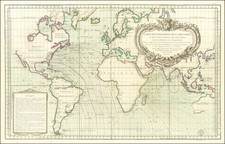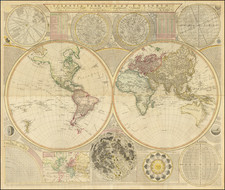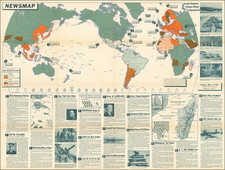Fine example of this scarce techtonic map of the World, published in Vienna by Freytag & Berndt, and edited by Professor Max Fritz, published in 1926.
The present map is one of the earliest maps to illustrate the theory of Plate Tectonics, coming just 14 years after the theory was first proposed and 3 years before Arthur Holmes first proposed the thermal convection theory which would ultimately underpin the generally accepted theory of continental drift. The map highlights the areas of Volcanic and Earthquake activity, along with other important geological features.
Overview
In 1912 Alfred Wegener (1880-1930) observed the coastal similarties of Africa, America and Europe, and proposed that the continents were once compressed into a single protocontinent which he called Pangaea (meaning "all lands"), and that over time the continents had drifted apart into their current distribution. He believed that Pangaea was intact until the late Carboniferous period, about 300 million years ago, when it began to break up and drift apart. However, Wegener's hypothesis lacked a geological mechanism to explain how the continents could drift across the earths surface as he proposed.
Searching for evidence to further develop his theory of continental drift, Wegener came across a paleontological paper suggesting that a land bridge had once connected Africa with Brazil. This proposed land bridge was an attempt to explain the well known paleontological observation that the same fossilized plants and animals from the same time period were found in South America and Africa. The same was true for fossils found in Europe and North America, and Madagascar and India. Many of these organisms could not have traveled across the vast oceans that currently exist. Wegener's drift theory seemed more plausible than land bridges connecting all of the continents.. Another observation favoring continental drift was the presence of evidence for continental glaciation in the Pensylvanian period. Striae left by the scraping of glaciers over the land surface indicated that Africa and South America had been close together at the time of this ancient ice age. The same scraping patterns can be found along the coasts of South America and South Africa.
Wegener's drift hypothesis also provided an alternate explanation for the formation of mountains (orogenesis). The theory being discussed during his time was the "Contraction theory" which suggested that the planet was once a molten ball and in the process of cooling the surface cracked and folded up on itself. The big problem with this idea was that all mountain ranges should be approximately the same age, and this was known not to be true. Wegener's explanation was that as the continents moved, the leading edge of the continent would encounter resistance and thus compress and fold upwards forming mountains near the leading edges of the drifting continents. The Sierra Nevada mountains on the Pacific coast of North America and the Andes on the coast of South America were cited. Wegener also suggested that India drifted northward into the asian continent thus forming the Himalayas.
Wegener eventually proposed a mechanism for continental drift that focused on his assertion that the rotation of the earth created a centrifugal force towards the equator. He believed that Pangaea originated near the south pole and that the centrifugal force of the planet caused the protocontinent to break apart and the resultant continents to drift towards the equator. He called this the "pole-fleeing force". This idea was quickly rejected by the scientific community primarily because the actual forces generated by the rotation of the earth were calculated to be insufficient to move continents. Wegener also tried to explain the westward drift of the Americas by invoking the gravitational forces of the sun and the moon, this idea was also quickly rejected. Wegener's inability to provide an adequate explanation of the forces responsible for continental drift and the prevailing belief that the earth was solid and immovable resulted in the scientific dismissal of his theories.
In 1929, about the time Wegener's ideas began to be dismissed, Arthur Holmes elaborated on one of Wegener's many hypotheses; the idea that the mantle undergoes thermal convection. This idea is based on the fact that as a substance is heated its density decreases and rises to the surface until it is cooled and sinks again. This repeated heating and cooling results in a current which may be enough to cause continents to move. Arthur Holmes suggested that this thermal convection was like a conveyor belt and that the upwelling pressure could break apart a continent and then force the broken continent in opposite directions carried by the convection currents. This idea received very little attention at the time.
Not until the 1960's did Holmes' idea receive any attention. Greater understanding of the ocean floor and the discoveries of features like mid-oceanic ridges, geomagnetic anomalies parallel to the mid-oceanic ridges, and the association of island arcs and oceanic trenches occurring together and near the continental margins, suggested convection might indeed be at work. These discoveries and more led Harry Hess (1962) and R.Deitz (1961) to publish similar hypotheses based on mantle convection currents, now known as "sea floor spreading". This idea was basically the same as that proposed by Holmes over 30 years earlier, but now there was much more evidence to further develop and support the idea.









![[Rare Complete Example with Game Pieces] Grand Circuit Des Capitales. Collection Concours Du Chocolat Menier](https://storage.googleapis.com/raremaps/img/small/70922rd.jpg)


![[Wall Map] Orbis Terrarum Nova et Accurata Tabula. Auct. G. Valck.](https://storage.googleapis.com/raremaps/img/small/41630dc.jpg)

